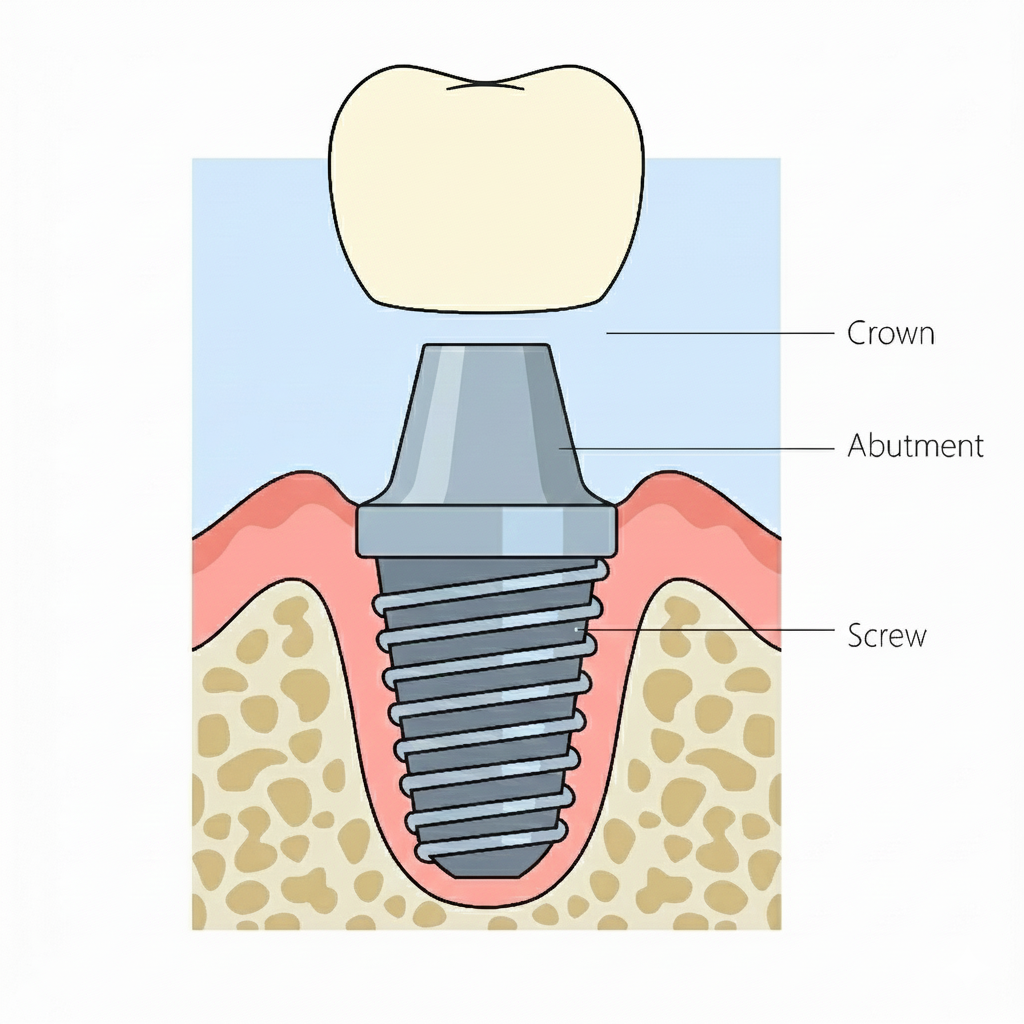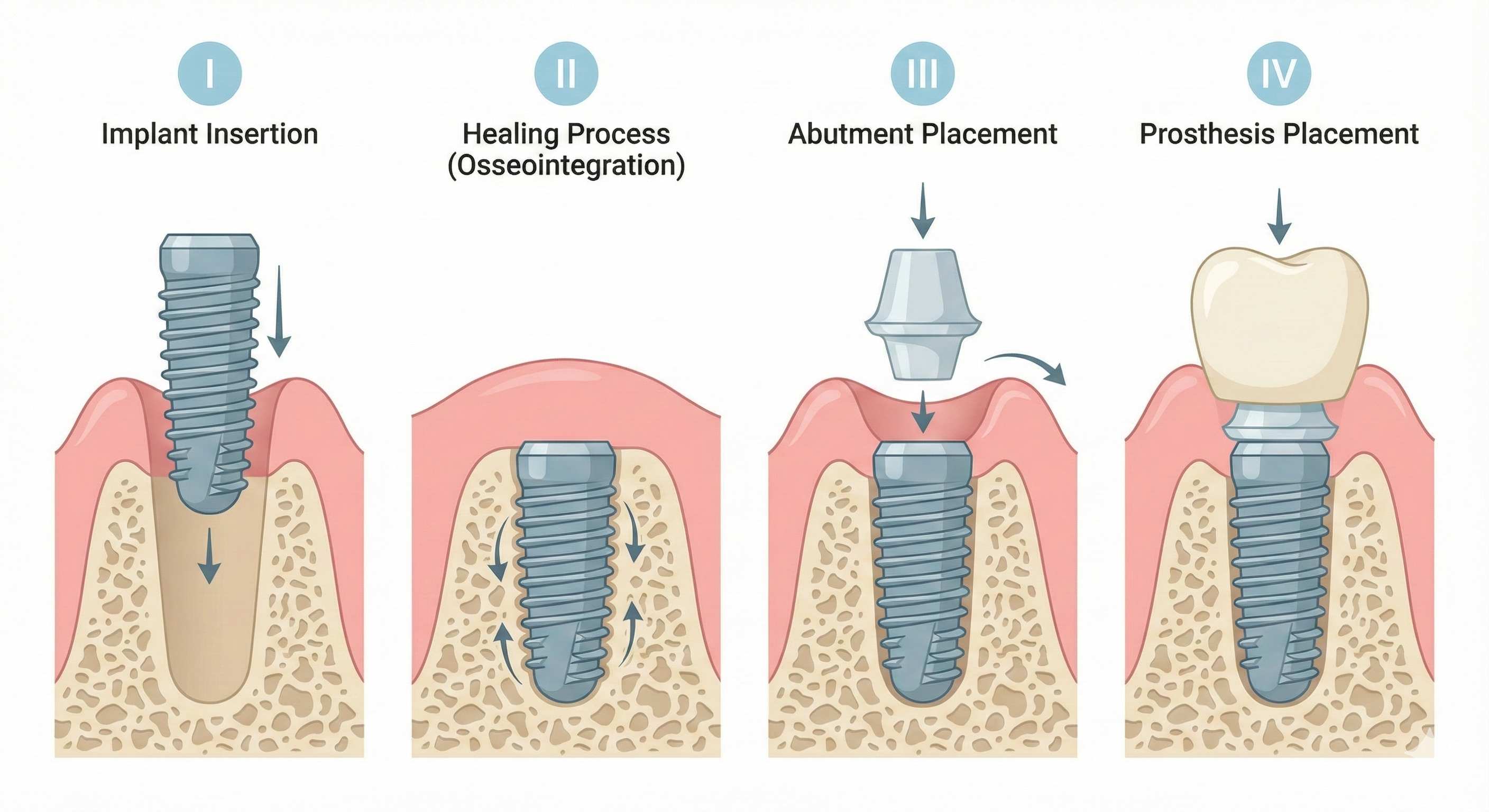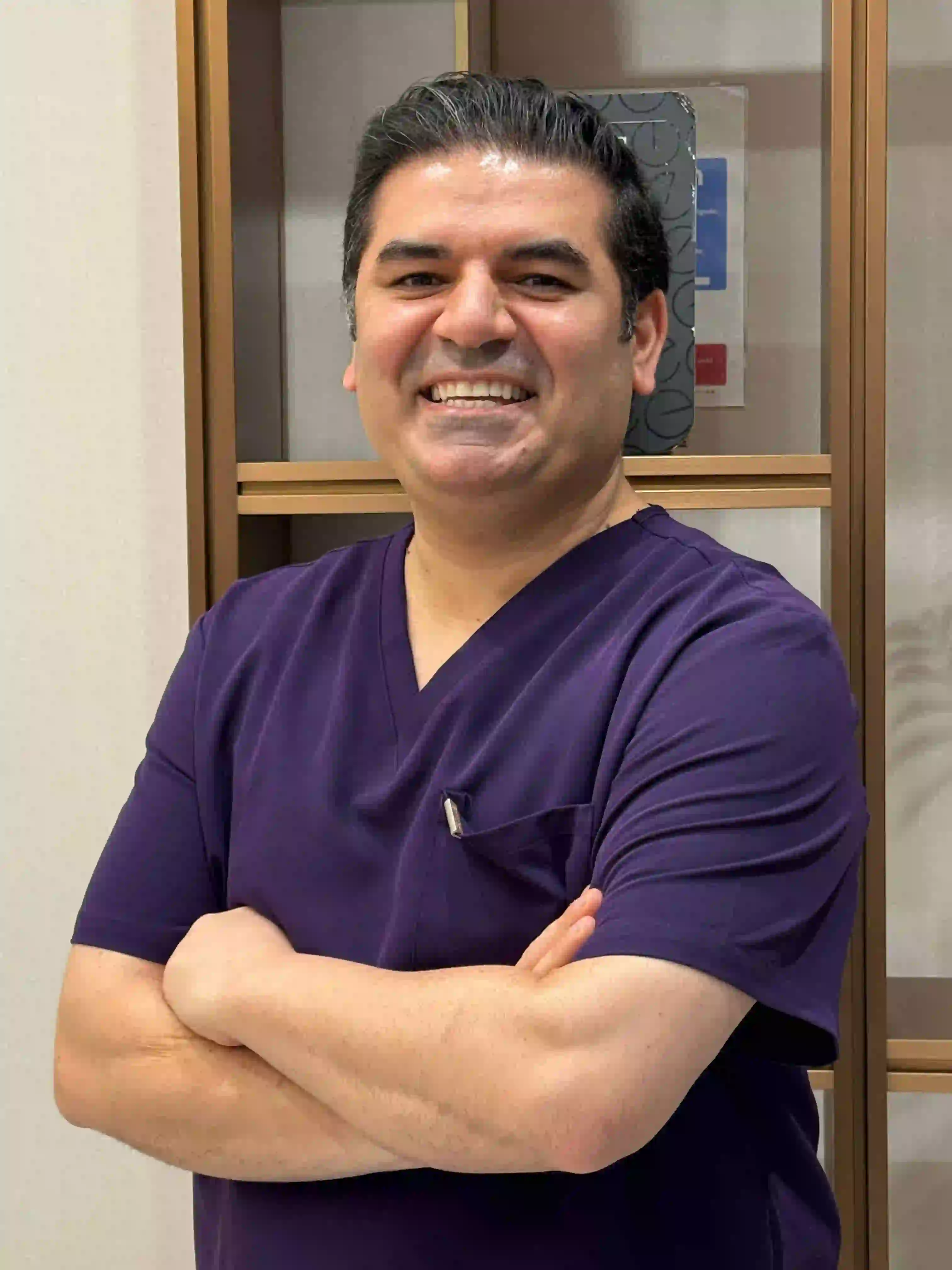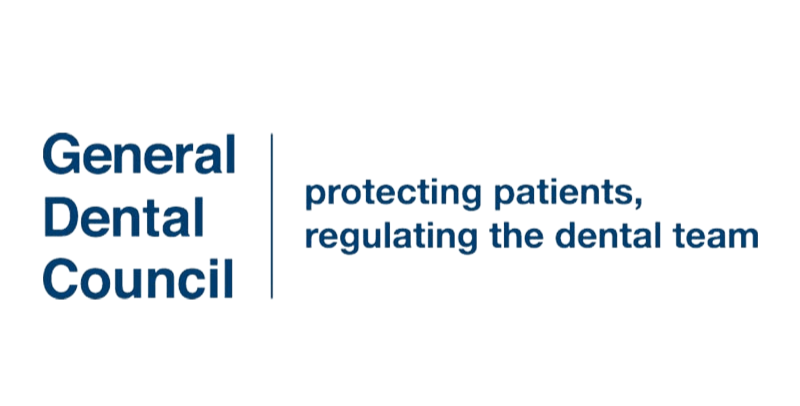The Department of Bio-Architecture
Dental Implants London | From £1,475 | South Kensington
Expert dental implants in SW7. Swiss Straumann system from £1,475 (members). Same-week consultations. CQC registered. 95% success rate. Book today.
The Art of Permanence
A lost tooth is not merely an aesthetic gap; it is a structural silence. We restore the dialogue between form and function with Swiss-engineered precision.
The South Kensington Standard
- Swiss Precision: We utilise world-leading implant systems (Straumann/Neodent) for unmatched osseointegration.
- Bio-Mimetic: Zirconia crowns that mimic the translucency and strength of natural enamel.
- Guided Surgery: Digital planning for minimally invasive placement and faster healing.
- Lifetime Focus: A permanent solution designed to outlast traditional dentistry.
The Investment
- Guest Fee: From £2,950.00 (Implant + Crown)
- Member Fee: From £1,475.00 (50% Privilege Reduction)
The Philosophy: Restoration, Not Replacement
In the past, dentistry offered compromises for missing teeth: removable dentures that slipped, or bridges that required filing down healthy adjacent teeth. These were "replacements."
At the Cosmetic Dentistry Clinic, we offer Restoration.
A dental implant is the only treatment that replaces the entire tooth structure—including the root. By integrating a biocompatible titanium fixture into the jawbone, we halt the bone loss that inevitably follows tooth extraction. We are not just filling a gap; we are preserving the structural integrity of your face.
The Silent Luxury Difference
We do not rush. We do not use "generic" components. We treat implantology as a form of bio-architecture, building a foundation that allows you to eat, speak, and laugh with the unthinking confidence of your natural teeth.
The Anatomy of an Implant
Understanding the engineering helps alleviate the anxiety of the procedure. A dental implant is composed of three precision-engineered components.

1. The Fixture (The Root)
A medical-grade titanium or zirconia screw is gently placed into the jawbone. Titanium is used because it is osteophilic (bone-loving); your body does not reject it but actually fuses to it in a process called Osseointegration.
2. The Abutment (The Connector)
Once the bone has healed around the fixture, we attach a precision connector. This acts as the shock absorber and the foundation for the visible tooth.
3. The Prosthesis (The Crown)
The final masterpiece. Our master ceramists hand-craft a porcelain or zirconia crown that matches the shade, texture, and light reflection of your natural teeth. It is screwed or cemented onto the abutment, becoming a seamless part of your smile.
Treatment Options: Tailored to Your Architecture
Whether you are missing a single tooth or require a full-arch rehabilitation, our South Kensington experts tailor the solution to your biology.
A. Single Tooth Replacement
The gold standard for a missing tooth. Unlike a bridge, this does not touch or damage the neighbouring teeth. It stands alone, strong and independent.
B. Implant-Supported Bridges
If you are missing 3 or 4 teeth in a row, you do not need an implant for every single one. We can place two implants (like the piers of a bridge) and support a row of three or four ceramic teeth between them. This is cost-effective and structurally sound.
C. All-on-4™
For patients who are edentulous (missing all teeth) or facing the loss of failing teeth, we offer the All-on-4 or All-on-6 protocol.
- The Concept: We place 4 to 6 implants at strategic angles to maximise bone support.
- The Result: We can often fit a full arch of fixed, non-removable teeth on the same day as the surgery. You wake up with a new smile.
The Process: A Journey of Precision
We operate under a protocol of "Digital Planning, Analogue Artistry." Every step is calculated to minimise trauma and maximise success.

Step 1: The Blueprint (Consultation & CT Scan)
We begin with a CBCT Scan (3D X-Ray). This allows us to see the exact density of your bone, the position of nerves, and the shape of your sinus. We "place" the implant virtually on the computer before we ever touch your mouth.
Member Benefit: Consultation & Diagnostics receive priority scheduling.
Step 2: The Placement (Surgery)
Under strict sterile protocols and effective local anaesthesia (or sedation if requested), the implant is placed.
- Pain Level: Most patients report less discomfort than a tooth extraction. You are usually back to work the next day.
- The Healing: We typically wait 3 to 6 months for Osseointegration (bone fusion) to occur. During this time, you will wear a temporary tooth so you never have a gap.
Step 3: The Unveiling (Restoration)
Once integrated, we uncover the implant and take a digital scan of the gum profile.
Step 4: The Installation
Your final custom crown is fitted. We check the bite with micron-precision paper to ensure the forces are balanced. You leave with a tooth that feels, looks, and functions like your own.
Addressing Complexity: Bone Grafting & Sinus Lifts
In the world of Silent Luxury, we do not shy away from complexity. We manage it.
If you have been missing teeth for years, your jawbone may have shrunk (resorbed). Other clinics may have told you that you "do not have enough bone" for implants. At Cosmetic Dentistry Clinic, we specialise in Bone Regeneration.
Bone Grafting
We place biocompatible bone material at the site to rebuild the width and height of the ridge.
Sinus Lift
In the upper jaw, if the sinus floor is too low, we gently lift it and place bone underneath to create a safe foundation for the implant.
Clinical Insight: These advanced procedures allow almost anyone to be a candidate for implants, regardless of how long they have been missing teeth.
The Investment: Fees & Privilege Access
Dental implants are an investment in the next 20, 30, or 40 years of your life. While the upfront cost is higher than a denture, the lifetime value is incomparable.
We believe in absolute transparency. Through our Privilege Programme, we have made world-class implantology accessible by removing the financial barrier.
Fee Structure
The following rates apply immediately upon enrolment in the Privilege Programme (£20/month).
| Treatment Component | Standard Guest Fee | Privilege Member Fee | Your Immediate Benefit |
|---|---|---|---|
| Implant Fixture & Crown (Complete) | From £2,950.00 | From £1,475.00 | 50% Courtesy |
| Surgical Extraction | From £350.00 | From £175.00 | 50% Courtesy |
| Bone Grafting (If required) | From £500.00 | From £250.00 | 50% Courtesy |
| Sinus Lift | From £750.00 | From £375.00 | 50% Courtesy |
| CT Scan (3D Imaging) | £150.00 | Included / Reduced | Priority Access |
Fiscal Insight: A single implant treatment saves a Member £1,475. This covers the cost of your membership for over 6 years. It is, quite simply, the only logical way to pay for implant treatment.
Why South Kensington Chooses Us
1. The "Clean Room" Protocol
Infection control is the single biggest factor in implant success. We operate with hospital-grade sterility. Our surgical suites are prepared with the same rigour as an operating theatre.
2. The Aesthetic Eye
Many dentists can place an implant, but few can make it look natural. The "emergence profile" (how the tooth comes out of the gum) is critical. We sculpt the gum tissue so the tooth looks like it is growing from the gum, not sitting on top of it.
3. The Components
We do not use "clone" implants. We use premium, research-backed systems (such as Straumann or Neodent) that have decades of clinical data. We put quality materials in your body because we want them to last a lifetime.
Frequently Asked Questions (FAQ)
Does the surgery hurt?
It is a common misconception that implant surgery is painful. In reality, it is often less traumatic than a tooth extraction. We use profound local anaesthesia. Most patients manage comfortably with over-the-counter painkillers (like Ibuprofen) the next day.
How long do implants last?
With proper hygiene and maintenance, dental implants are designed to be a permanent solution. Unlike bridges, which often fail after 10-15 years due to decay, implants cannot decay. The main risk is gum disease (peri-implantitis), which is why our hygiene protocol is essential.
Can I smoke?
Smoking significantly increases the risk of implant failure by restricting blood flow to the bone. We strongly advise cessation during the healing phase. If you are a smoker, we will discuss the risks openly with you.
What if my body rejects the implant?
True "rejection" (like an organ transplant) does not happen with titanium. However, occasionally the bone fails to fuse (non-integration). This is rare (success rates are over 95%). If this happens, we remove the implant, let the bone heal, and try again.
Is there an age limit?
No. As long as you have finished growing (usually over 18), there is no upper age limit. We successfully treat patients in their 80s who wish to eat steak and apples again.
Reclaim Your Function
A missing tooth is a compromise you do not need to accept. Restore the architecture of your face and the confidence of your smile with the most advanced solution in modern dentistry.
Secure Your Future
Step 1: The Diagnostics
Book a Consultation to assess your bone density.
Step 2: The Membership (Recommended)
Join the Privilege Programme (£20/m) upon arrival to secure the £1,475 rate.
Same-day consultations available
Cosmetic Dentistry Clinic
20 Old Brompton Road, South Kensington, London, SW7 3DL

Expert Insight
"We approach dental implants london | from £1,475 | south kensington not just as a procedure, but as a pivotal restoration of self. Precision is our baseline; artistry is our signature."
— Dr. Yasha Y Shirazi
The Process
- 01.
Comprehensive Diagnostics & 3D Imaging.
- 02.
Bespoke Treatment Planning & Aesthetic Calibration.
- 03.
Precision Execution & Final Artistry.
Benefits
- Improved Facial Harmony
- Restored Function & Longevity
- Seamless, Natural Aesthetics
Client Voices
"We had an appointment with Dr. Yasha Shirazi, and he was absolutely wonderful... The clinic is new and fully renovated, offering a completely different level of service... far beyond what we typically experience in London."
"By far, the best dental procedure I have received. Clean place, welcoming reception staff. The doctor is nice, straightforward, clear, and concise. Could not ask for more."
"Amazing treatment. Receptionist is welcoming and kind. Jack did my treatment — super amazing. He explained everything in detail. I love my teeth after treatment. Thanks 😊"
"I had the absolute pleasure of being seen by Layla... Layla provided an exceptional hygiene service — thorough, gentle, and attentive to every detail. I left feeling refreshed, confident, and incredibly satisfied."
"Jack is a wonderful hygienist! I suffer from TMJD and usually struggle... but this visit was completely different. He put me at ease right away. For the first time in a long while, the cleaning didn’t hurt much at all."
"We were fortunate enough to be looked after by Jack... His professionalism and friendly manner were exceptional. If you are looking for an amazing, caring hygienist, we absolutely recommend Jack."
"We had an appointment with Dr. Yasha Shirazi, and he was absolutely wonderful... The clinic is new and fully renovated, offering a completely different level of service... far beyond what we typically experience in London."
"By far, the best dental procedure I have received. Clean place, welcoming reception staff. The doctor is nice, straightforward, clear, and concise. Could not ask for more."
"Amazing treatment. Receptionist is welcoming and kind. Jack did my treatment — super amazing. He explained everything in detail. I love my teeth after treatment. Thanks 😊"
"I had the absolute pleasure of being seen by Layla... Layla provided an exceptional hygiene service — thorough, gentle, and attentive to every detail. I left feeling refreshed, confident, and incredibly satisfied."
"Jack is a wonderful hygienist! I suffer from TMJD and usually struggle... but this visit was completely different. He put me at ease right away. For the first time in a long while, the cleaning didn’t hurt much at all."
"We were fortunate enough to be looked after by Jack... His professionalism and friendly manner were exceptional. If you are looking for an amazing, caring hygienist, we absolutely recommend Jack."
"We had an appointment with Dr. Yasha Shirazi, and he was absolutely wonderful... The clinic is new and fully renovated, offering a completely different level of service... far beyond what we typically experience in London."
"By far, the best dental procedure I have received. Clean place, welcoming reception staff. The doctor is nice, straightforward, clear, and concise. Could not ask for more."
"Amazing treatment. Receptionist is welcoming and kind. Jack did my treatment — super amazing. He explained everything in detail. I love my teeth after treatment. Thanks 😊"
"I had the absolute pleasure of being seen by Layla... Layla provided an exceptional hygiene service — thorough, gentle, and attentive to every detail. I left feeling refreshed, confident, and incredibly satisfied."
"Jack is a wonderful hygienist! I suffer from TMJD and usually struggle... but this visit was completely different. He put me at ease right away. For the first time in a long while, the cleaning didn’t hurt much at all."
"We were fortunate enough to be looked after by Jack... His professionalism and friendly manner were exceptional. If you are looking for an amazing, caring hygienist, we absolutely recommend Jack."
Location
Cosmetic Dentistry Clinic20 Old Brompton Road
South Kensington
London, SW7 3DL
Located 2 minutes walk from South Kensington Station.
Opening Hours
- Mon - Wed09:00 - 18:00
- Thu09:00 - 20:00
- Fri09:00 - 17:00
- Sat10:00 - 16:00
- SunClosed
Uncompromising Standards
True artistry requires a foundation of absolute safety. Our practice operates under the strictest clinical governance, ensuring that your journey is as safe as it is transformative. We are fully regulated, transparent, and dedicated to the highest tenets of medical ethics.
Begin Your Journey
Private consultations available in South Kensington. Join our membership for exclusive courtesies.

